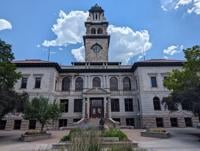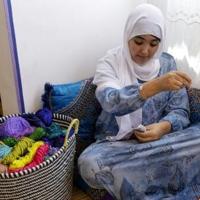If museums don’t collect women’s art, women’s stories won’t be told.
And that would mean losing half of American history.
“Across the globe museums are taking time to reflect on their role as gatekeepers and tastemakers,” said Colorado Springs Pioneers Museum’s Curator of History Leah Davis Witherow. “By not collecting women artists we’re not exhibiting them. How is the public supposed to know that women are creating art?”
The museum’s new exhibit, “50% of the Story: Women Expressing Creativity,” is the first of its kind in Colorado — a permanent exhibit devoted to art created by women. It features about 150 works by women artists, 68 of which are contemporary pieces by local artists that are now part of the museum’s permanent collection. Those pieces are surrounded by work and artifacts culled from the museum’s collection going back to 1896.
While reimagining the museum’s art collection, Witherow ran into an alarming statistic: “We were finding some startling numbers that 9 out of about every 10 works of art in an American museum is a work of art made by man.”
And that just wouldn’t do.
“Women have always been artistic and creative and artists, but their work hasn’t always been seen,” Witherow said. “How were they creative when the doors to art training and formal gallery representation were closed to them? They created something else, a beautiful object that had a utilitarian purpose, a scrapbook or hand crafts, they crocheted, knitted, made a piece of clothing, took a photo. There’s a variety of objects in the exhibit that demonstrate the ways women have created something beautiful out of every day objects. They’ve imbued those objects with memory and meaning and love and story.”
Visitors to the gallery might first be drawn to oil painter Sushe Felix’s “Glorious Garden of Light,” with its brilliant colors and Southwest scene. Adjacent to the large piece are two oil paintings: “General Palmer” by Jess Preble, featuring Colorado Springs founder Brig. Gen. William J. Palmer, and “Motherling” by Lindsay Hand, the first portrait ever done of Palmer’s wife, Mary Lincoln “Queen” Mellen Palmer. The museum commissioned Hand to do the work.
Nearby is Alice Ann Ochs’ serene sculpture “Mother and Child.” Sculptures by the artist, who died last year, can be spotted around the city, including Colorado Springs Fine Arts Center at Colorado College, Humane Society of the Pikes Peak Region and Patty Jewett Golf Course.
“Illustrious,” a majestic acrylic self-portrait by Jeresneyka Rose, also commissioned by the museum, is a standout with its corn-yellow colors.
“Usually women are seen as a supporting role, especially in the patriarchy — women supporting men,” Rose said. “But we have taken an active role in society since forever, we’re just not highlighted. We are part of history. Women have and always will be creative beings and creating work that is museum-worthy.”
Some pieces in the exhibit might challenge a visitor’s definition of art, Witherow says, such as the 1840 piece “Shadowbox with Hair Wreath” by Mrs. Harry Knight, who took hair from dead loved ones and wove it on wire to create intricate designs.
“How do you commemorate your loved ones in an era pre-photography?” Witherow said. “You don’t have a photo of them so you have a piece of their hair. Who could argue that is not beautiful? That’s probably hundreds of hours of work.”
Wendy Mike’s small mixed-media sculpture, “Narissah Revealed,” is juxtaposed with Southern Ute painter and metalsmith Debra Box’s “Beaded Deer Hide Bag” and Joyce B. Gilmer’s cookbook, “A Few of My Favorite Things.”
“Her creativity was cooking for people and feeding their body and soul,” Witherow said.
Artists who create with words and their bodies also are featured. On one wall is a screen playing a video of Pikes Peak Poet Laureate Ashley Cornelius reading her commissioned poem, “Prismatic”: “We (women) are the universe’s best kept secret.”
“Mile,” a dance performance by Lilly Parsons, can be accessed through a QR code on the wall of an exhibit, as can a monologue by actor Lynne Hastings from “Every Brilliant Thing.”
“The amount of gratitude these artists have to be in the permanent collection of the museum and to be part of Colorado Springs history is huge for them,” said Gundega Stevens, co-owner of Auric Gallery.
Stevens was part of a curatorial team that helped discover art and artists for the exhibit. The team also included CSPM exhibit designer Kelly Murphy and Auric Gallery co-owner Abigail Kreuser. Through their years as gallery owners, Stevens and Kreuser have historically shown more women artists.
“Colorado Springs has a strong history of art schools and artists,” Stevens said, “and working with Kelly and Leah you see how many female artists have made an impact in this region.”
Some of the artists in the exhibit are formally trained, while others picked up painting during the pandemic as a form of therapy.
“Who gets to decide which one belongs in a museum?” Witherow said. “Who gets to decide who gets to call themselves an artist? That’s gatekeeping. And we wanted to create a space that was welcoming for every artist in the region. We couldn’t include everyone but we hope when people come they see something that mirrors their experience.”
This post was originally published on this site be sure to check out more of their content









